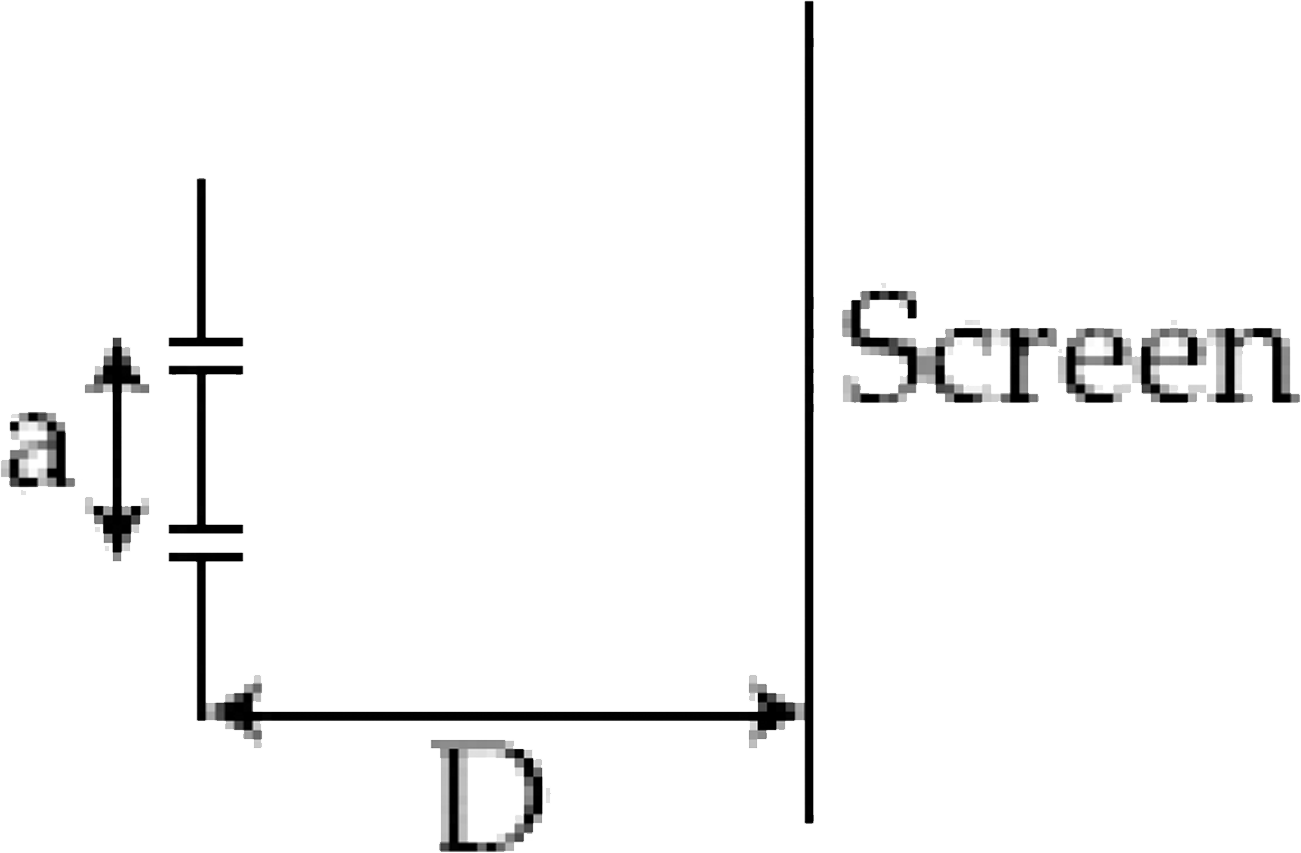Interference fringes were produced in Young's double-slit experiment using light of wavelength 5000Å. When a film of thickness 2.5×10−3cm was placed in front of one of the slits, the fringe pattern shifted by a distance equal to 20 fringe-widths. The refractive index of the material of the film is
1.25
1.35
1.4
1.5
The correct Answer is:C
To solve the problem, we will follow these steps:
Step 1: Understand the given data
- Wavelength of light, λ=5000Å=5000×10−10m=5×10−7m
- Thickness of the film, t=2.5×10−3cm=2.5×10−5m
- The fringe pattern shifts by 20 fringe-widths.
Step 2: Relate the shift in fringe pattern to the refractive index
The shift in the fringe pattern due to the introduction of the film is given by the formula:
Δy=(n−1)⋅t⋅Dd
where:
- Δy is the shift in the fringe pattern,
- n is the refractive index of the film,
- t is the thickness of the film,
- D is the distance from the slits to the screen,
- d is the distance between the slits.
Step 3: Express the fringe width
The fringe width β is given by:
β=λDd
Thus, the shift Δy can also be expressed in terms of fringe width:
Δy=20⋅β=20⋅λDd
Step 4: Set the two expressions for shift equal
Equating the two expressions for the shift, we have:
(n−1)⋅t⋅Dd=20⋅λDd
Step 5: Cancel common terms
Since Dd appears on both sides, we can cancel it out:
(n−1)⋅t=20⋅λ
Step 6: Solve for the refractive index n
Rearranging the equation gives:
n−1=20⋅λt
Thus,
n=1+20⋅λt
Step 7: Substitute the values
Substituting the values of λ and t:
n=1+20⋅(5×10−7)2.5×10−5
Step 8: Calculate the value
Calculating the fraction:
20⋅(5×10−7)2.5×10−5=100×10−72.5×10−5=1002.5⋅10−2=40⋅10−2=0.4
Thus,
n=1+0.4=1.4
Final Answer
The refractive index of the material of the film is n=1.4.
---
- Wavelength of light, λ=5000Å=5000×10−10m=5×10−7m
- Thickness of the film, t=2.5×10−3cm=2.5×10−5m
- The fringe pattern shifts by 20 fringe-widths.
The shift in the fringe pattern due to the introduction of the film is given by the formula:
Δy=(n−1)⋅t⋅Dd
where:
- Δy is the shift in the fringe pattern,
- n is the refractive index of the film,
- t is the thickness of the film,
- D is the distance from the slits to the screen,
- d is the distance between the slits.
The fringe width β is given by:
β=λDd
Thus, the shift Δy can also be expressed in terms of fringe width:
Δy=20⋅β=20⋅λDd
Equating the two expressions for the shift, we have:
(n−1)⋅t⋅Dd=20⋅λDd
Since Dd appears on both sides, we can cancel it out:
(n−1)⋅t=20⋅λ
Rearranging the equation gives:
n−1=20⋅λt
Thus,
n=1+20⋅λt
Substituting the values of λ and t:
n=1+20⋅(5×10−7)2.5×10−5
Calculating the fraction:
20⋅(5×10−7)2.5×10−5=100×10−72.5×10−5=1002.5⋅10−2=40⋅10−2=0.4
Thus,
n=1+0.4=1.4
The refractive index of the material of the film is n=1.4.
Topper's Solved these Questions
- BOOK - DC PANDEY ENGLISHCHAPTER - WAVE OPTICSEXERCISE - taking it together47videos
WAVE OPTICS
- BOOK - DC PANDEY ENGLISHCHAPTER - WAVE OPTICSEXERCISE - Assertion reason8videos
WAVE OPTICS
- BOOK - DC PANDEY ENGLISHCHAPTER - WAVE OPTICSEXERCISE - For JEE Advanced E. Integer Type Questions13videos
WAVE OPTICS
- BOOK - DC PANDEY ENGLISHCHAPTER - SOLVED PAPERS 2018EXERCISE - JIPMER22videos
SOLVED PAPERS 2018
Similar Questions
YDSE is conducted using light of wavelength 6000Å to observe an interference pattern. The slits are 2mm apart. The fringes are observed on a screen 10cm away from the slits. When a film of some material 0.5mm thick was placed over one of the slits, the fringe pattern shifted by a 5mm. What is the refractive index of the material of the film ?
View SolutionFind the angular fringe width in a Young's double slits experiment with blue-green light of wavelength 6000A. The separation between the slits is 3.0×10−3m.
View Solution
Knowledge Check
- Question 1 - Select One
Interference fringes were produced in Young's double slit experiment using light of wavelength 5000 Ã…. When a film of material 2.5×10−3cm thick was placed over one of the slits, the fringe pattern shifted by a distance equal to 20 fringe widths. The refractive index of the material of the film is
A1.25B1.33C1.4D1.5
Find the angular fringe width in Young's double slit experiment using a monochromatic light of wavelength 500 nm when the slits are separated by 2.5 mm.
View SolutionThe figure shows a Young's double slit experimental setup. It is observed that when a thin transparent sheet of thickness t and refractive index μ is put front of one of the slits, the central maximum gets shifted by a distance equal to n fringe widths. If the wavelength of light used is λ, t will be :
 View Solution
View SolutionIn Young's double slit experiment, when light of wavelength 4000A∘ is used 90 fringes are seen on the screen. When light of 3000 A is used, the number of fringes seen is
View SolutionIn Young's double-slit experiment, let A and B be the two slit. A thin film of thickness t and refractive index μ is placed in front of A. Let β= fringe width. Then the central maxima will shift
View SolutionIn a doulble slit experiment when a thin film of thickness t having refractive index μ is introduced in from of one of the slits, the maximum at the centre of the fringe pattern shifts by one width. The value of t is (λ is the wavelength of the light used)
View SolutionIn Young.s double slit experiment, blue-green light of wavelength 500nm is used. The slits are 1.20mm apart, and the viewing screen is 5.40m away from the slits. What is the fringe width.
View SolutionInterference fringes were produced using light in a doulbe-slit experiment. When a mica sheet of uniform thickness and refractive index 1.6 (relative to air) is placed in the path of light from one of the slits, the central fringe moves through some distance. This distance is equal to the width of 30 interference bands if light of wavelength 4800 is used. The thickness (in μm) of mica is
View Solution

